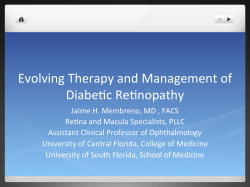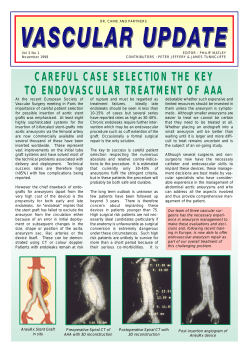
NICE UPDATE Peripheral Arterial Disease (CG147, August 2012)
NICE UPDATE Peripheral Arterial Disease (CG147, August 2012) Avon GP Education Engineers’ House, Bristol Thursday 10th January 2013 Mr M J Brooks Consultant Vascular and Endovascular Surgeon University Hospitals Bristol NHS Foundation Trust Intermittent claudication 20% of over 60 year olds Smoking, Diabetes, Coronary disease Critical limb ischaemia 20% of population with claudication 40 per 100,000 UK population (1995) Acute limb ischaemia National Reporting and Learning System 51 delays reported: 7 deaths and 44 severe harm Marker cardiovascular events The 5 year cumulative mortality for men with intermittent claudication is 4.8% - 17% • 50% die from cardiac event This is over twice that considered acceptable by the Health Service Framework for Coronary Heart Disease (NSF/CHD) (70% of patients have coronary disease) 1 • 7% -17% die from stroke • 10% other vascular event, e.g. ruptured AAA 2 1 Bainton D, Sweetnam P, Baker I, Elwood P. Peripheral vascular disease: consequence for survival and association with risk factors in the Speedwell prospective heart disease study. Br Heart J 1994; 72: 128-132. 2 Scottish Intercollegiate Guidelines Network. Drug therapy for PVD. SIGN 1998;27. 3/5 of PAD patients ‘poly-vascular’ disease Mortality CVD 3.5% Injuries and poisoning 14.0% Respiratory 27.0% Cancer 27.3% Atherothrombosis* 0 5 10 15 20 25 30 Mortality (%) *Atherothrombosis bar is an addition of burden for coronary heart disease (17.3%), cerebrovascular disease (9.9%) and peripheral arterial disease (no data) 1. England and Wales, Office for National Statistics 2006 (www.heartstats.org) Case 1 60 year old female Pain in left calf on walking 200 metres Smoker 15 cigarettes/day Mild COPD (inhalers) Rarely consults GP History? Risk factors Other arterial disease Quality of life? Examination? Atrial fibrillation Abdominal aortic aneurysm Pulse status Investigation? ABPI Bloods Arterial Duplex Management? Supervised exercise programme Angioplasty Common femoral Deep femoral or profunda femoris Superficial femoral Popliteal Anterior tibial Posterior tibial Peroneal Dorsalis pedis ABPI Intermittent Claudication ? ABPI Normal Poor History Unlikely Vascular No Fall In Pressures Incompressible Reduced (<0.9) Good History Exercise Test Poor History Needs Duplex Good History Fall in Pressures Peripheral arterial disease ? Differential diagnosis Radicular pain nerve root compression ‘sciatica’ Spinal stenosis cauda equina compression Worse by walking but also manifests on standing Pain not rapidly relieved by rest, may need to sit forward Venous claudication Rare – only in setting deep venous occlusion Orthopaedic Gout Diabetic neuropathy Original Event = Stroke MI Risk • 2-3 x greater risk2* Stroke Risk • 9 x greater risk3 Original Event = MI MI Risk • 5-7 x greater risk1+ Stroke Risk • 3-4 x greater risk2++ Original Event = PAD MI Risk • 4 x greater risk4** Stroke Risk • 2-3 x greater risk3++ Diabetes (type 2) Because of the increased risk associated with diabetes, it should be considered a cardiovascular risk equivalent to a non-diabetic patient with previous MI Data is increased risk vs general population (%) *Includes angina and sudden death. Sudden death defined as death documented within 1 hour and attributed to coronary heart 1. Adult Treatment Panel II. Circulation 1994; 89:1333–63. disease (CHD) **Includes only fatal heart attack and other CHD death; does not include non-fatal heart attack, 2. Kannel WB. Jdeath Cardiovasc Risk 1994; 1: 333–9. + Includes ++Includes TIA 3. Wilterdink JI, Easton JD. Arch Neurol1992; 49: 857–63. 4. Criqui MH et al. N Engl J Med 1992; 326: 381–6. Risk factors •Modifiable Smoking PAD Leading cause of preventable death in the Western World - 1 in 5 deaths attributable to cigarettes - Single most important risk factor for PAD (x3 increased1risk) Cessation may reduce severity of claudication Persuading patients to stop is notoriously difficult 2 Reduces risk of developing rest pain Rate can be improved with support (< 2% to 27%) ●nicotine patches ●counselling ●behaviour modification 1 Girolami et al. Meta-analysis 1999; 159: 337-345. ● bupropion 2 Janoson et al. Acta Med Scand 1987; 221: 253-60. Risk factors •Modifiable Hyperlipidaemia Guidelines: JBS2 Targets: BHS4 (2004)1 <4 mmol/l total cholesterol1,2 Joint British Societies 22 <2 mmol/l LDL cholesterol1,2 Simvastatin reduced Aincidence claudication diet low in of saturated fats2 in patients All1patients with acute atherosclerotic with prior MI or angina disease to receive a statin in hospital 2 regardless of cholesterol value Simvastatin & Atorvastatin improve pain free walking time PAD 1 4-S Study. Am J Cardiol. 1998; 81: 333-5. 2 Aronow et al. Am J Cardiol. 2003 & Mohler et al. Circulation. 2003. 2 HPS: Effect reducing LDL cholesterol by 1 mmol/l Vascular event SIMVASTATIN PLACEBO (10269) (10267) Major coronary 898 1212 Any stroke 444 585 CABG / PCI 939 1205 2033 (19.8%) 2585 (25.2%) All Rate ratio & 95% CI STATIN better PLACEBO better 24% SE 3 reduction (2P<0.00001) 0.4 HPS Collaborative Group. Lancet 2002;360:7–22. 0.6 0.8 1.0 1.2 1.4 HPS and PAD Simvastatin 40 mg Reduced risk of bypass, angioplasty or amputation Women as well as men People aged over 70 PAD (Comparable to stroke and diabetes) 5 years of Simvastatin typically prevented major vascular events in 70 of every 1,000 patients (NNT 14) c.f. 100 of every 1000 past MI, 80 of every 1000 angina LDL-C Secondary Prevention (stable CHD) 30 Event (%) 25 Statin Placebo 4S 4S 20 15 HPS 10 TNT80 5 0 3 CARE 70 90 LIPID LIPID TNT10 110 CARE HPS 130 150 LDL-C (mg/dL) 170 190 210 TNT=Treating to New Targets (80mg & 10 mg Atorvastatin); HPS=Heart Protection Study (40 mg Simvastatin); CARE=Cholesterol and Recurrent Events Trial (Pravastatin 40mg); LIPID=Long-term Intervention with Pravastatin in Ischaemic Disease (Pravastatin 40mg); 4S=Scandinavian Simvastatin Survival Study (40mg Simvastatin). LaRosa et al. N Engl J Med 2005;352:14251435. Risk factors •Modifiable PAD Hypertension Beta-blockers do not worsen intermittent claudication Guidelines: Target BP: BHS4 (2004)1 < 140/85 mmHg1,2, or Captopril & Perindopril may improve distance 2 1,2 JBS2 (2005) < 130/80 mmHgwalking with diabetes 1 2 Ramipril reduced risk stroke, MI and vascular death Lowering Systolic 10-12 mmHg and Diastolic 5-6 mmHg 3 even in symptomatic patients with PAD (RRR 1 reduces risk stroke by 38% and coronary event 16%.25%) Intensive control Ca prevents in diabetic Diuretics,BP B-Blockers, channelevents antagonists, ACE inhibitors 4 & AT-II receptor antagonists all effective at reducing CV events 2 patients with PAD 1 Radack et al. Meta-analysis. Arch Intern Med. 1991; 151: 1769-76. 1 Lindholm et al. Meta-analysis. Lancet 2005; 366: 1545-53. 2 Lip et al. Cochrane review. 2003; (2) CD003075. 2 Blood pressure Lowering Trialists Collaboration. Lancet 2003; 362: 3 HOPE Study. NEJM 2000; 342: 145-53. 1527-35. 4 ABCD Study. Mehler et al. Circulation 2003; 107: 753-6. HOPE Ramipril in patients at high risk for cardiovascular events who did not have LV dysfunction or heart failure. 9000 patients older than age 55 years were enrolled Reduction in MI, stroke and cardiovascular death in the treatment group (P < .05); all types of patients benefited from being on the ACE inhibitor on subset analyses. Eighteen deaths prevented for every 1000 patients treated; considering all major vascular events: 128 of every 1000 patients (NNT of 8). ALLHAT Cumulative Event Rates for the Primary Outcome (Fatal CHD or Nonfatal MI) by ALLHAT Treatment Group Cumulative CHD Event Rate .2 RR (95% CI) p value 0.98 (0.90-1.07) 0.65 0.99 (0.91-1.08) 0.81 A/C L/C .16 Chlorthalidone Amlodipine Lisinopril .12 .08 .04 0 0 1 2 3 4 Years to CHD Event 5 6 7 Relative Risk of All-cause Mortality Relative Risk of Cardiovascular Disease Mortality Overweight and Obesity Increase the Risk of Cardiovascular Disease Mortality and All-Cause Mortality 3.0 2.6 2.2 Men Women CVD Mortality 1.8 1.4 1.0 0.6 >18 3.0 2.6 2.2 Normal Weight Overweight 25 BMI (kg/m2) Men Women Obese 30 >40 All-cause Mortality 1.8 1.4 1.0 0.6 >18 Normal Weight Overweight 25 BMI (kg/m2) Obese 30 >40 Data are from 1 million men and women followed for 16 years with an average age of 57 who never smoked and had no history of disease at enrollment. Calle et al. N Engl J Med 1999;341:10971105. Risk factors •Modifiable Lifestyle Diet: 2 servings fish/week, 5 fruit or veg/day, fat intake less than 30% energy intake (no more than one third saturated), dietary cholesterol less than 300mg/day and low salt 100 mg/day. PAD Exercise significantly improves maximal walking Alcohol: Menoverall limit to 3-4 units/day, Women limit to 2-3 units/day. 1 time and walking ability Activity: Non-sedentary with or without time Intermittent walkingoccupation to near maximal painleisure over 6 months activity or 30 mins of moderate aerobic exercise each day i.e. brisk 1Leng using et al. Cochrane Review CD000990 walking, stairs, cycling or 2000;(2): swimming. 2 Gardner at al. Meta-analysis. JAMA 1995; 274: 975-80. 2 Platelet Inhibition ADP Pathway ADP Clopidogrel Inhibits ADP platelet aggregation pathway Aspirin Inhibits thromboxane A2 platelet aggregation pathway C ADP Receptor PLATELET COX TXA2 Receptor Dipyridamole Inhibits phosphodiesterase induced cAMP release cAMP Pathway TXA2 TXA2 Pathway Phosphodiesterase Patients having an event (%) Aspirin vs. Placebo1 18 16 23% relative risk reduction over and above placebo • Primary endpoint -non-fatal MI -non-fatal stroke -or vascular death • 135,000 high-risk patients in 195 trials 14 12 10 8 6 4 2 0 1. Adapted from Antithrombotic Trialists' Collaboration. BMJ 2002; 324: 71–86. Placebo Aspirin Trials of antiplatelet agents Category % odds reduction Acute myocardial infarction Acute stroke Prior myocardial infarction Prior stroke/transient ischemic attack • • • • CAD (e.g. unstable angina, heart failure) PAD (e.g. intermittent claudication) Risk of embolism (e.g. atrial fibrillation) Other (e.g. diabetes) All trials 0.0 0.5 Antiplatelet better *Vascular events = myocardial infarction, stroke or vascular death 1. Antithrombotic Trialists’ Collaboration. BMJ 2002; 324: 71–86 1.0 1.5 2.0 Control better Efficacy of clopidogrel* CAPRIE study ‘high-risk patients’ Cumulative event rate (%) Clopidogrel 75mg versus Aspirin 325mg 16 • Ischaemic stroke • MI • Peripheral arterial disease 12 ASA 325mg RRR=8.7% n = 9586 (p=0.043) 8 Clopidogrel 75mg n = 9599 4 0 0 3 6 9 12 15 18 21 24 27 30 33 36 Months of follow-up With clopidogrel there was a 8.7% relative risk reduction for further MI or CVA 5.32% Clopidogrel versus 5.83% atherothrombotic events over ASA Aspirin *Entry criteria were a diagnosis of; ischaemic stroke, MI or symptomatic atherosclerotic peripheral arterial disease 1. CAPRIE Steering Committee. Lancet 1996; 348: 1329–1339 Clopidogrel Clopidogrel is recommended by NICE for PAD patients (TA 210) CAPRIE ESPS-2 ESPRIT PRoFESS PAD Clopidogrel risk of first CVA, MI or Vascular death compared with aspirin by 23.8% relative risk reduction (8.9-36.2) Multi-vascular Clopidogrel risk of first CVA, MI or Vascular death compared with aspirin by 14.9% relative risk reduction (0.3-27.3) Cumulative Impact of Simple Cardiovascular Protective Medications Relative Risk 2 Yr. CV Event Rate --- 20% Aspirin 25% 15% Beta Blocker 25% 11.3% ACE Inhibitor 25% 8.4% Lipid-lowering Rx 30% 5.9% LDL-C 100 70 mg/dL 16% 5.0% None Cumulative risk reduction if all four therapies are used: 75% Absolute risk reduction: 15%, NNT = 6 Cardiovascular (CV) Event = CV death, myocardial infarction, or stroke LDL-C=low-density lipoprotein cholesterol Fonarow GC et al. Am J Cardiol 2000;85:10A17A. Yusuf S. Lancet 2002;360:23. Case 2 76 year old male Pain in left foot constantly for 2 weeks Now unable to walk, previously pain in thigh and calf at 50 m MI 5 years (PCI) Ex-smoker 5 years Hypertension Hypercholesterolaemia History? Risk factors Other arterial disease Examination? Atrial fibrillation Abdominal aortic aneurysm Pulse status Investigation? ABPI Bloods Arterial Duplex MR Angiogram Management? Multi-disciplinary - Vascular surgery - Interventional radiology - Pain team - Physiotherapy and OT Imaging Treatment - Occlusive Bypass Medical Balloon angioplasty Supervised exercise Endarterectomy Stent Arterial pathology Occlusive Aneurysm Embolic Congenital Inflammatory Acute ischaemia and Rupture Outcome for legs Patients may be reassured that, with respect to their legs, the condition usually runs a benign course – risk of symptoms developing is 5-10% over 5 years 1 – less than 1 in 20 symptomatic patients will progress to rest pain or gangrene each year (15-20 per 100,000) 2 – 52/100,000 patients hospitalised p.a. – less than 1 in 3 will require a surgical (radiological) intervention 1 Hooi et al. Br J Gen Pract 1999; 49: 49-55. 2 Fowkes et al. Edinburgh Artery Study. Int J Epidemiol 1991; 20: 384-92. Case 3 68 year old male with Type II DM Painless ulcer on left foot Non-smoker Recent short course oral antibiotics History? Risk factors Other arterial disease Neuropathy Examination? Pulse status Superficial or deep infection Systemic infection Investigation? ABPI Bloods – including CRP, Glu Plain film Arterial Duplex Management? Multi-disciplinary Rx - Diabetic foot Podiatry Diabetologist Vascular Orthopaedic Microbiologist Putting feet first ‘Ulcers’ Rest pain and gangrene more common in diabetics 1 1 Am. Diabetes Association. Diabetes Care 2003; 26: 3333-41. Major amputation in diabetics One every 2 seconds in the world 80 every week in the UK The Diabetic Foot Neuropathic Ischaemic Infective The Diabetic Foot Neuropathic Ischaemic Infective Bristol, Bath and Weston AAA Screening Programme Abdominal Aortic Aneurysm The NHS AAA Screening Programme Shona Marriage Programme Coordinator Marcus Brooks Clinical Director Teresa Robinson Ultrasound Lead Vicky Davis Clinical Skills Trainer Programme Office Vascular Surgery Level 2, Dolphin House Bristol Royal Infirmary BS2 8HW 0117 342 1480 aaascreening@uhbristol.nhs.uk National programme website – aaa.screening.nhs.uk aaa.screening.nhs.uk aaa.screening.nhs.uk Who is eligible in 2012/13 • Men who turn 65 between 01/04/12 to 31/03/13 (Y1 cohort - identified Connecting for Health System) – First invitation letters have been sent – All will receive invitations by mid March 2013 • • Men aged over 65 can self refer by contacting the programme office. There is no evidence of benefit from AAA screening in younger men or women aaa.screening.nhs.uk Possible outcomes Normal (Aorta < 3 cm) • Subject discharged from programme • Result sent to GP in writing Small or Medium AAA (3.0 – 5.4 cm) • Surveillance scan (3 or 12 months) • Result sent to GP in writing Large AAA (≥ 5.5 cm) • Referral to vascular surgeon for diagnosis and treatment • Result sent to GP in writing aaa.screening.nhs.uk
© Copyright 2025





















